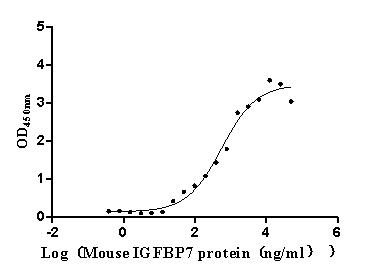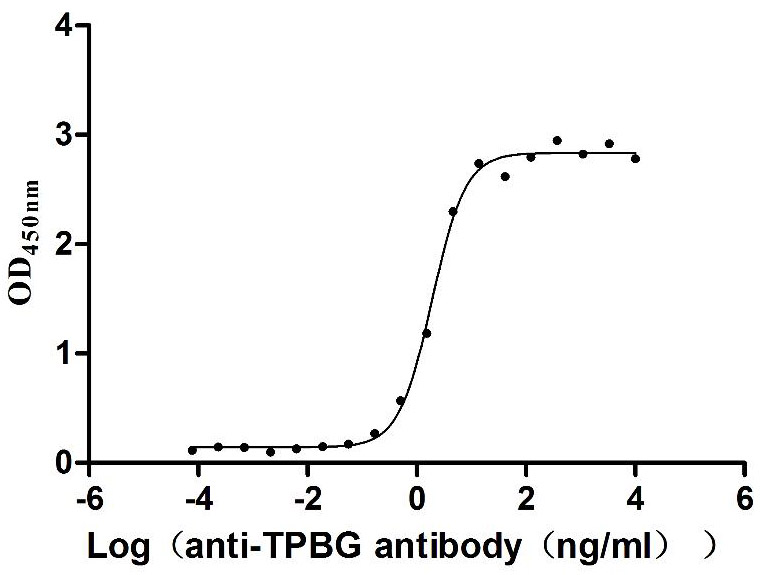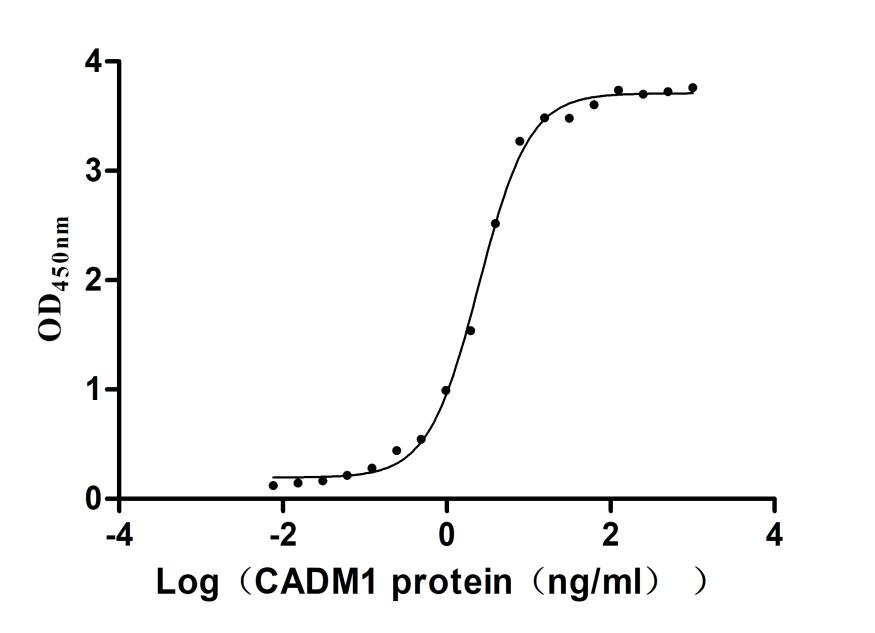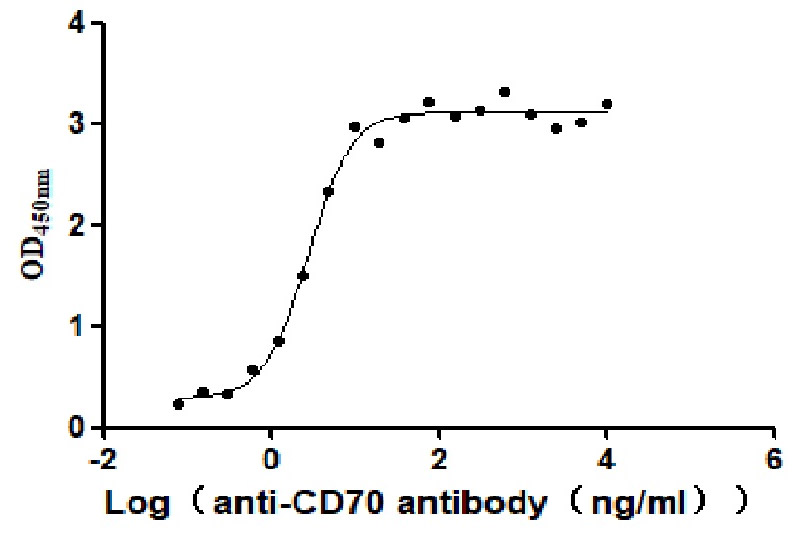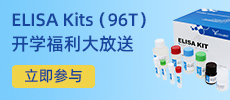Recombinant Human Extracellular sulfatase Sulf-1 (SULF1), partial
-
中文名稱:人SULF1重組蛋白
-
貨號:CSB-EP814217HU-B
-
說明書:
-
規格:
-
來源:E.coli
-
共軛:Avi-tag Biotinylated
E. coli biotin ligase (BirA) is highly specific in covalently attaching biotin to the 15 amino acid AviTag peptide. This recombinant protein was biotinylated in vivo by AviTag-BirA technology, which method is BriA catalyzes amide linkage between the biotin and the specific lysine of the AviTag.
-
其他:
產品詳情
-
純度:>85% (SDS-PAGE)
-
基因名:SULF1
-
Uniprot No.:
-
別名:DSulf; Extracellular sulfatase Sulf 1; Extracellular sulfatase Sulf-1; Extracellular sulfatase Sulf1 ; HSULF 1; HSulf-1; Neu5; Sulf1; SULF1_HUMAN; Sulfatase FP; Sulfated
-
種屬:Homo sapiens (Human)
-
蛋白長度:Partial
-
蛋白標簽:Tag?type?will?be?determined?during?the?manufacturing?process.
The tag type will be determined during production process. If you have specified tag type, please tell us and we will develop the specified tag preferentially. -
產品提供形式:Lyophilized powder
Note: We will preferentially ship the format that we have in stock, however, if you have any special requirement for the format, please remark your requirement when placing the order, we will prepare according to your demand. -
復溶:We recommend that this vial be briefly centrifuged prior to opening to bring the contents to the bottom. Please reconstitute protein in deionized sterile water to a concentration of 0.1-1.0 mg/mL.We recommend to add 5-50% of glycerol (final concentration) and aliquot for long-term storage at -20℃/-80℃. Our default final concentration of glycerol is 50%. Customers could use it as reference.
-
儲存條件:Store at -20°C/-80°C upon receipt, aliquoting is necessary for mutiple use. Avoid repeated freeze-thaw cycles.
-
保質期:The shelf life is related to many factors, storage state, buffer ingredients, storage temperature and the stability of the protein itself.
Generally, the shelf life of liquid form is 6 months at -20°C/-80°C. The shelf life of lyophilized form is 12 months at -20°C/-80°C. -
貨期:Delivery time may differ from different purchasing way or location, please kindly consult your local distributors for specific delivery time.Note: All of our proteins are default shipped with normal blue ice packs, if you request to ship with dry ice, please communicate with us in advance and extra fees will be charged.
-
注意事項:Repeated freezing and thawing is not recommended. Store working aliquots at 4°C for up to one week.
-
Datasheet :Please contact us to get it.
相關產品
靶點詳情
-
功能:Exhibits arylsulfatase activity and highly specific endoglucosamine-6-sulfatase activity. It can remove sulfate from the C-6 position of glucosamine within specific subregions of intact heparin. Diminishes HSPG (heparan sulfate proteoglycans) sulfation, inhibits signaling by heparin-dependent growth factors, diminishes proliferation, and facilitates apoptosis in response to exogenous stimulation.
-
基因功能參考文獻:
- High SULF1 expression is associated with glioma. PMID: 29360432
- These findings suggested that SULF1 could be an indicator of the clinicopathological features and prognosis of pancreatic cancer. PMID: 29843217
- Defective autophagy is associated with loss of HSulf-1 in ovarian cancer. PMID: 28169314
- our study found that increased SULF1 expression is significantly predictive of more advanced tumor stage and poorer metastasis-free survival and disease-specific survival in patients with both UTUC and UBUC. PMID: 28525382
- Data show that sulfatase 1 (hSulf-1) overexpression in melanoma cells can inhibit cell proliferation and induce cell cycle arrest and apoptosis by decreasing the protein kinase B (AKT) phosphorylation and limiting cyclin dependent kinase 4 (CDK4) nuclear import. PMID: 27806323
- Sulf-1 is responsive to TNF-alpha stimulation and may function as an autocrine regulator of fibroblast expansion in the course of an inflammatory response PMID: 27693418
- The short variants of Sulf1 promoted FGF2-induced MDA-MB231 and MCF7 in vitro growth while full-length Sulf1 inhibited growth supporting in vivo mammary tumour cell signalling patterns of growth. PMID: 27294358
- The SULF1/SULF2 activation thus does not only promote regulated foetal growth and injury-induced liver regeneration but also dysregulated tumour growth. PMID: 27013228
- Results show that SULF1 or SULF2 overexpression contributes to colorectal cancer cell proliferation, migration, and invasion. PMID: 25477293
- Data suggest that Sulfatase 1 (hSulf-1) may be a suitable target for cancer therapy. PMID: 24970807
- findings show an upregulation of SULF1 in degenerative discs for the first time, and suggest that there is a link between SULF1 and disc degeneration PMID: 25469740
- rs6990375 polymorphism of SULF1 gene could be one of the factors related to recurrent miscarriage in Iranian women. PMID: 24322345
- identification of markers including SULF1 may improve detection of this disease at its earliest stages improving patient treatment and prognosis PMID: 24911625
- SULF1/SULF2 splice variants regulate pancreatic tumor progression. PMID: 24726914
- Knockdown of SULF2 in human corneal epithelial cell line slowed migration, which was restored by overexpression of either mouse SULF2 or human SULF1. PMID: 23950901
- Strong interaction depends on the presence of Sulf1-substrate groups. PMID: 23891937
- Ectopic expression of SULF1 or SULF2 in HeLa cells, which decreases cell surface heparan sulfate proteoglycan sulfation, diminished Chlamydia muridarum binding and decreased vacuole formation. PMID: 23480519
- these observations provide evidence that HPEI nanogels delivering HSulf-1 combined with DDP may have a promising application in the therapy of human ovarian cancer. PMID: 22825572
- miR-21-mediated suppression of both hSulf-1 and PTEN led to activation of AKT/ERK pathways and epithelial-mesenchymal transition in hepatocellular carcinoma, promoting tumor growth. PMID: 23684551
- HSulf-1 and HSulf-2 share the same desulfation processs but with a different rate PMID: 23457216
- inhibits proliferation and invasion of esophageal squamous cell carcinoma by decreasing heparin-binding growth factor signaling PMID: 23053899
- HSULF-1 is expressed at lower levels in H292 lung cancer cells than in normal human alveolar cells and that its over-expression reduced cell viability in H292 cells by inducing apoptotic pathways, at least in part by inhibiting ERK/Akt signaling PMID: 22873647
- SULF1 may serve as a promising biomarker for patients with gastric carcinoma. PMID: 22653794
- Sulf-1 protein expression is down-regulated in gastric cancer. PMID: 22524839
- extracellular HSulf-1 may function as a negative regulator of proliferation and invasion in gastric cancer by suppressing Wnt/beta-catenin signaling at the cell surface. PMID: 21722266
- SULF1 and SULF2 are overexpressed in various human cancer types and can be associated to progression and prognosis. PMID: 21599997
- Data show that HSulf-1 depletion in breast cancer cells resulted in an increased and sustained bFGF2 (basic fibroblast growth factor) signaling and promoted cell migration and invasion under hypoxic conditions. PMID: 21266348
- Phage microarrays containing colorectal cancer cDNA libraries were prepared to identify phage-expressed peptides recognized by tumor-specific autoantibodies from patient sera. PMID: 21228115
- Genetic variations in SULF1 may play a role in ovarian cancer onset and prognosis. PMID: 21214932
- Haploinsufficiency of SULF1 combined with haploinsufficiency of SLCO5A1 (or the altered expression of a neighboring gene through position effect) could be necessary in the pathogenesis of MSS. PMID: 20602915
- The expression levels of four of the up-regulated genes, CXCL1, SPARC, SPP1 and SULF, were significantly higher in the cancerous tissue compared with the normal tissue (fold change 3.4-8.9). PMID: 19780053
- Sulfs are extracellular endosulfatases with strong potential for modulating the interactions of heparan sulfate proteoglycans in the extracellular microenvironment PMID: 12368295
- modulates signaling by heparin-binding growth factors, and HSulf-1 down-regulation represents a novel mechanism by which cancer cells can enhance growth factor signaling PMID: 12686563
- Down-regulation of hSulf1 contributes to hepatocarcinogenesis by enhancing heparin-binding growth factor signaling and resistance to apoptosis. PMID: 14699503
- High expression of Hsulf-1 occurs in the stromal elements as well as in the tumor cells in pancreatic cancer and interferes with heparin-binding growth factor signaling PMID: 15817123
- HSulf-1 and HSulf-2 have roles in inhibiting myeloma tumor growth PMID: 16192265
- Loss of HSulf-1 expression is associated with breast cancer PMID: 17363371
- Sulf1 is a TGF-beta1-responsive gene both in vitro and in vivo and may function as a negative regulator of TGF-beta1-induced fibrogenesis PMID: 18503048
- Increased sulf-1 expression may change the sulfation patterns of heparan sulfate proteoglycans and growth factor activities and thus contribute to abnormal chondrocyte activation and cartilage degradation in osteoarthritis. PMID: 18507859
- Sulf1 and Sulf2 are two heparan sulfate 6-O-endosulfatases that regulate the activity of multiple growth factors, such as fibroblast growth factor and Wnt, and are essential for mammalian development and survival PMID: 18687675
- detection of the HSulf-1 promoter methylation in serum samples may have clinical implications in early detection and diagnosis of human breast and gastric cancers. PMID: 19006069
- Strategies targeting sulfatase 1(SULF1) or the interaction between SULF1 and the related sulfatase 2 will potentially be important in developing novel cancer therapies. PMID: 19373441
- vHNF1 acts as a repressor of HSulf-1 expression and might be a molecular target for ovarian cancer therapy. PMID: 19487294
- analysis of the subdomain organization of sulf-1 and sulf-2 PMID: 19520866
- Data show that specific regions of the Sulf1 hydrophilic domain (HD) influence different aspects of heparan sulfate binding, cellular localization, and enzyme function. PMID: 19666466
- HSulf-1 (SULF1) and HSulf-2 (SULF2) are potent inhibitors of myeloma tumor growth in vivo. PMID: 16192265
顯示更多
收起更多
-
亞細胞定位:Endoplasmic reticulum. Golgi apparatus, Golgi stack. Cell surface.
-
蛋白家族:Sulfatase family
-
組織特異性:Expressed at highest levels in testis, stomach, skeletal muscle, lung, kidney, pancreas, small intestine and colon. It is also detected in normal ovarian surface epithelial cells. Down-regulation seen in ovarian carcinoma cell lines, ovarian cancers, brea
-
數據庫鏈接:
Most popular with customers
-
Recombinant Human Tumor necrosis factor ligand superfamily member 8 (TNFSF8), partial (Active)
Express system: Mammalian cell
Species: Homo sapiens (Human)
-
Express system: Mammalian cell
Species: Homo sapiens (Human)
-
Recombinant Human Cannabinoid receptor 1 (CNR1)-VLPs (Active)
Express system: Mammalian cell
Species: Homo sapiens (Human)
-
Recombinant Mouse Claudin-18.2 (Cldn18.2)-VLPs (Active)
Express system: Mammalian cell
Species: Mus musculus (Mouse)
-
Recombinant Mouse Complement component C1q receptor (Cd93), partial (Active)
Express system: Mammalian cell
Species: Mus musculus (Mouse)
-
Recombinant Macaca fascicularis Trophoblast glycoprotein (TPBG), partial (Active)
Express system: Mammalian cell
Species: Macaca fascicularis (Crab-eating macaque) (Cynomolgus monkey)
-
Recombinant Human Cytotoxic and regulatory T-cell molecule (CRTAM), partial (Active)
Express system: Mammalian cell
Species: Homo sapiens (Human)
-
Recombinant Human CD70 antigen (CD70), partial (Active)
Express system: Mammalian cell
Species: Homo sapiens (Human)


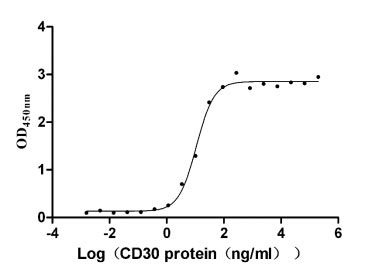
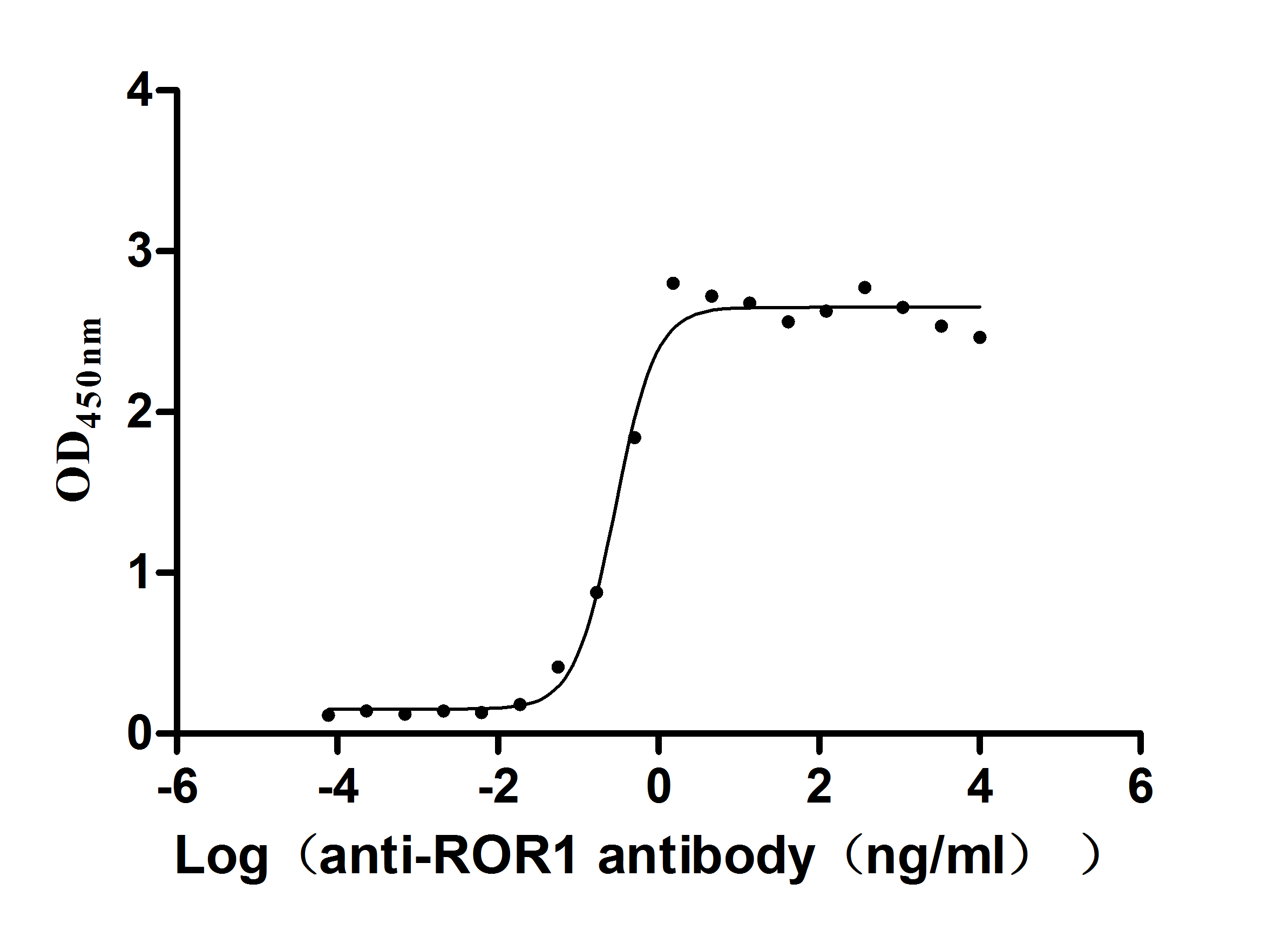
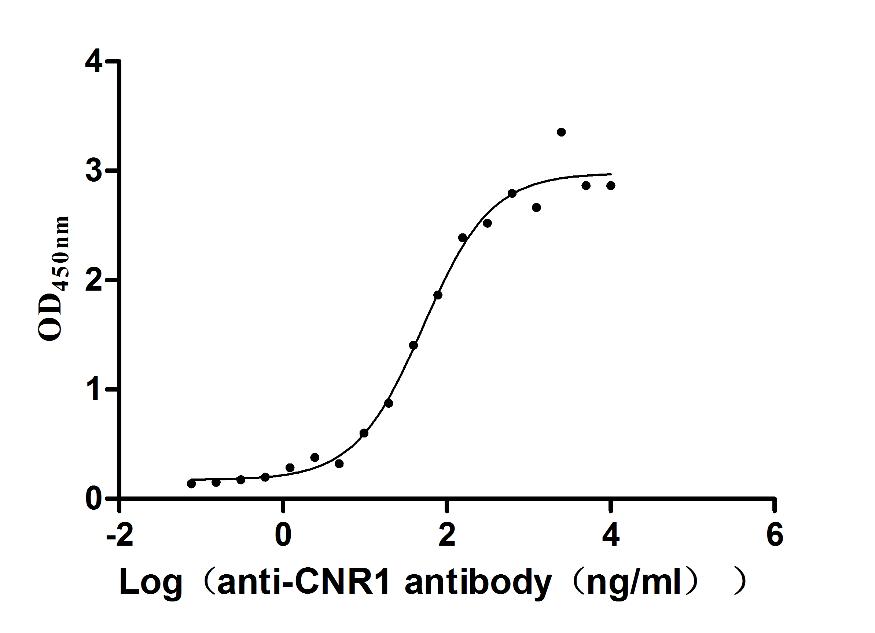
-AC1.jpg)
